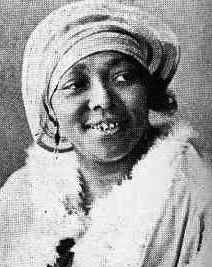 Ida Cox (1888 or 1896 - 1967)
Ida Cox (1888 or 1896 - 1967)
Apart from having a name which sounds like a dirty joke, she is known for being the “uncrowned queen of the blues”, and like many, perhaps all black people interested in music at the time, found an outlet for her talent in the choirs of the local church, and at age fourteen left home to work with the travellng vaudeville shows, one of which, the Rabbits Foot Minstrels, we have already come across with Brownie McGhee. This particular show would be responsible for introducing not just Cox but also two future giants of the blues in Ma Rainey and Bessie Smith.
It was her third husband, Jesse “Tiny” Crump, who would help her write her songs and also accompany her on the piano, as well as managing her career. She met him in 1927 and began recording songs for the genre then known as “race music”, which was basically, in a nutshell, music by black people for black people - blues, jazz, African beats, some comedy, all performed by black artists. Later we’ll see how sharply black and white were divided by radio and by record companies, leading to the former playing blues and jazz while the latter stuck to country music.
Cox’s commanding stage presence and powerful delivery made her a star, and she recorded albums and radio shows, and in 1929 through to 1935 she and her husband toured their revue show, Raisin’ Cain, across the south (playing in only black theatres, of course). The Great Depression though made it hard to continue, and in 1939 she played Carnegie Hall and then concentrated on making records, until her first retirement in 1945, occasioned by a stroke. She was coaxed out of retirement in 1961 and made one more album, but suffered a second stroke four years later and passed away in 1967, another victim of cancer.
She was a proud and independent woman, whose music sang of the injustices of her time and the plight of women, and of blacks in general. She broke many barriers, being one of the first black women to own and manage her own company, and also write her own songs. The lyric to one of her most famous songs is probably her best epitaph:
I've got a disposition and a way of my own,
When my man starts to kicking I let him find a new home,
I get full of good liquor, walk the street all night
Go home and put my man out if he don't act right
Wild women don't worry,
Wild women don't have the blues.
 Lucille Bogan (1897- 1948)
Lucille Bogan (1897- 1948)
One of the first of what were termed the “dirty blues” singers, certainly one of the first female examples, Bogan was known to use explicit images in her lyrics, and referenced drinking too, which would not have endeared her to the more polite side of society. She had very humorous sexual innuendos in her songs, and they have been recorded by many giants of the blues since, including the great B.B. King. She also recorded as Bessie Jackson, from about 1933. She was considered one of the “big three of blues”.
 Bessie Smith (1894 - 1937
Bessie Smith (1894 - 1937)
Brought up, like so many African-Americans of the period, in dreadful poverty, Smith’s parents died when she was only nine and she was brought up by her sister. When her brother joined a travelling troupe she wanted to go with him but was too young, but when the troupe came back to her hometown her brother arranged for her to join. Here she met Ma Rainey, who taught her how to work a stage. After playing in theatres she moved on to recording music in 1923, and was soon one of the most popular female blues artists of the day, earning her the title “Empress of the Blues.” She was the best-paid black performer of the time, and probably the first black person to have their own private railroad car to travel in.
Her death was the stuff of rock legends. Her boyfriend, while trying to overtake a slow truck, hit it and the roof of their car came off, taking off Bessie’s arm. In shock, she was being tended to by a doctor at the roadside when
another car sped up and, ignoring all warnings to stop, ploughed into the already-wrecked car. Taken to hospital (a “coloured” one of course) Bessie had her arm amputated but did not regain consciousness and died that morning, September 26 1937.
Her no-good husband made off with the proceeds of fundraising intended to have a headstone placed on Bessie’s grave, and it wasn’t till 1970, 33 years after her death, that one was finally erected thanks to Janis Joplin. Decades after her death she was awarded three posthumous Grammys, inducted into the National Women’s Hall of Fame and appeared on a US postage stamp.